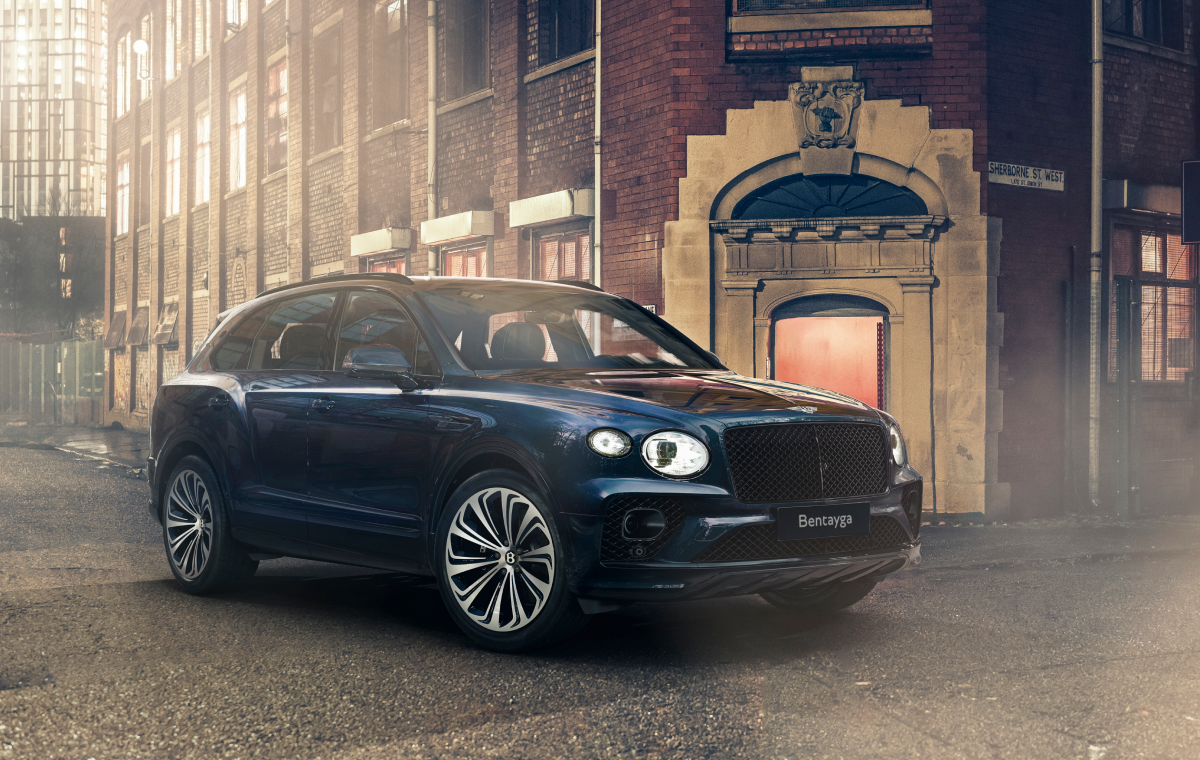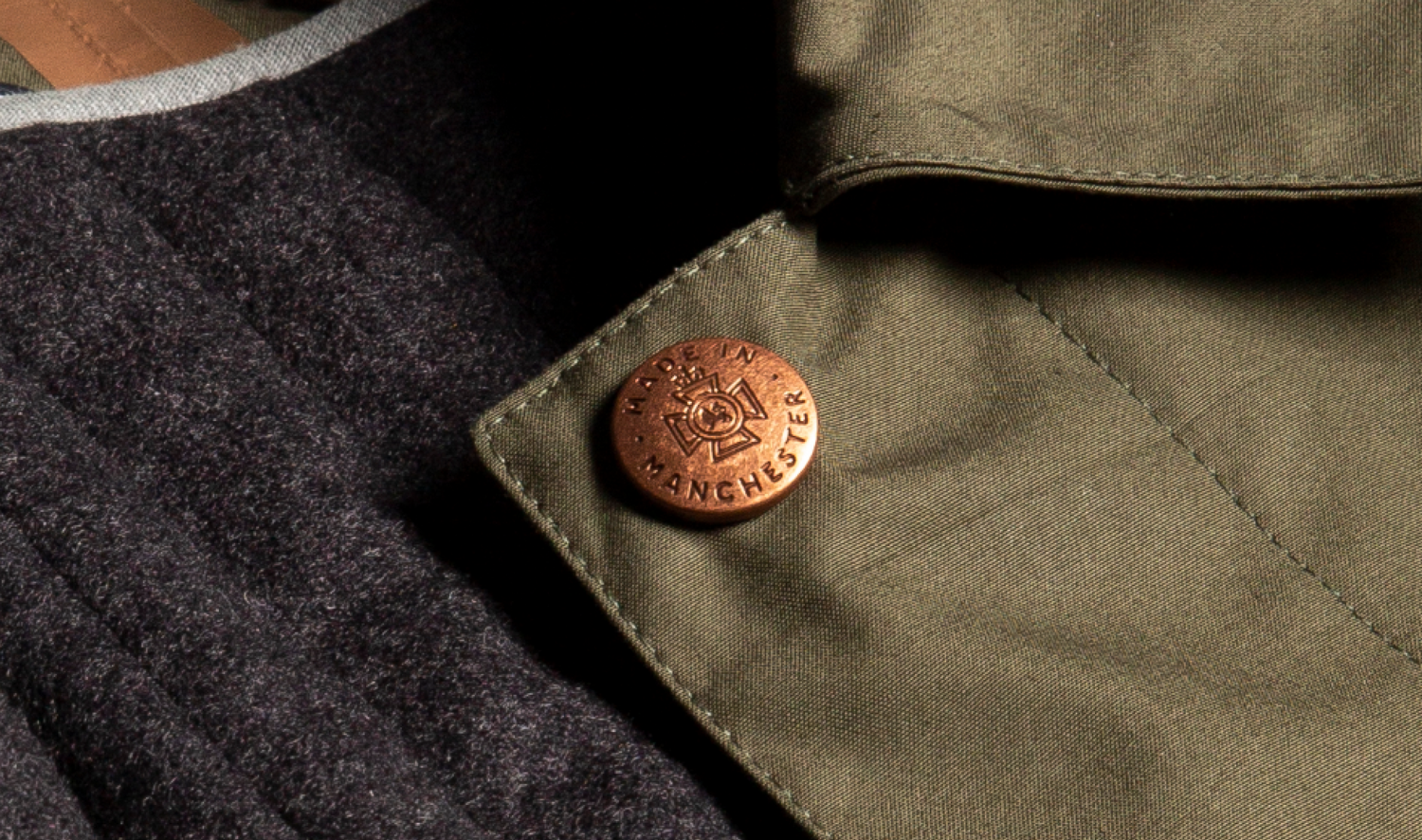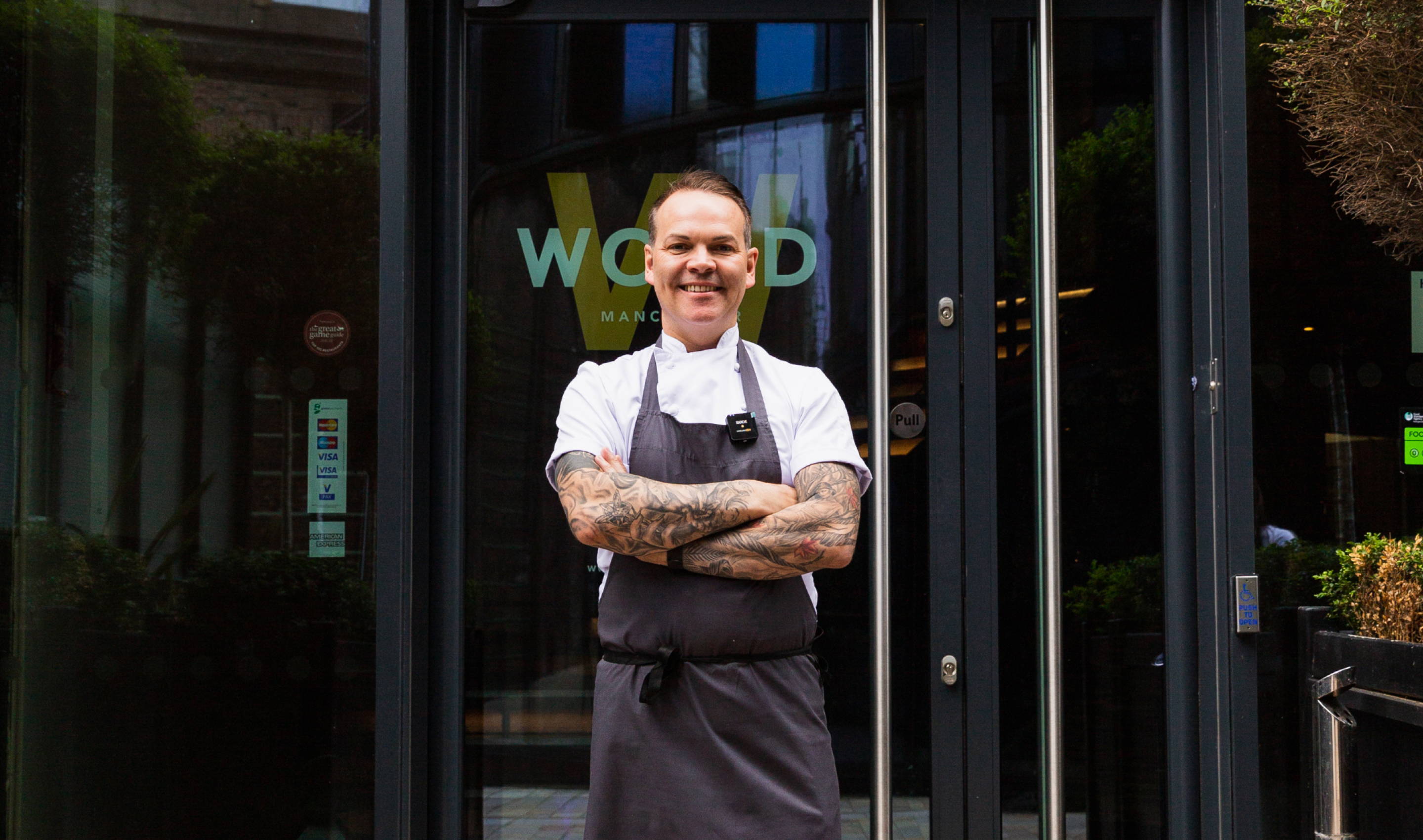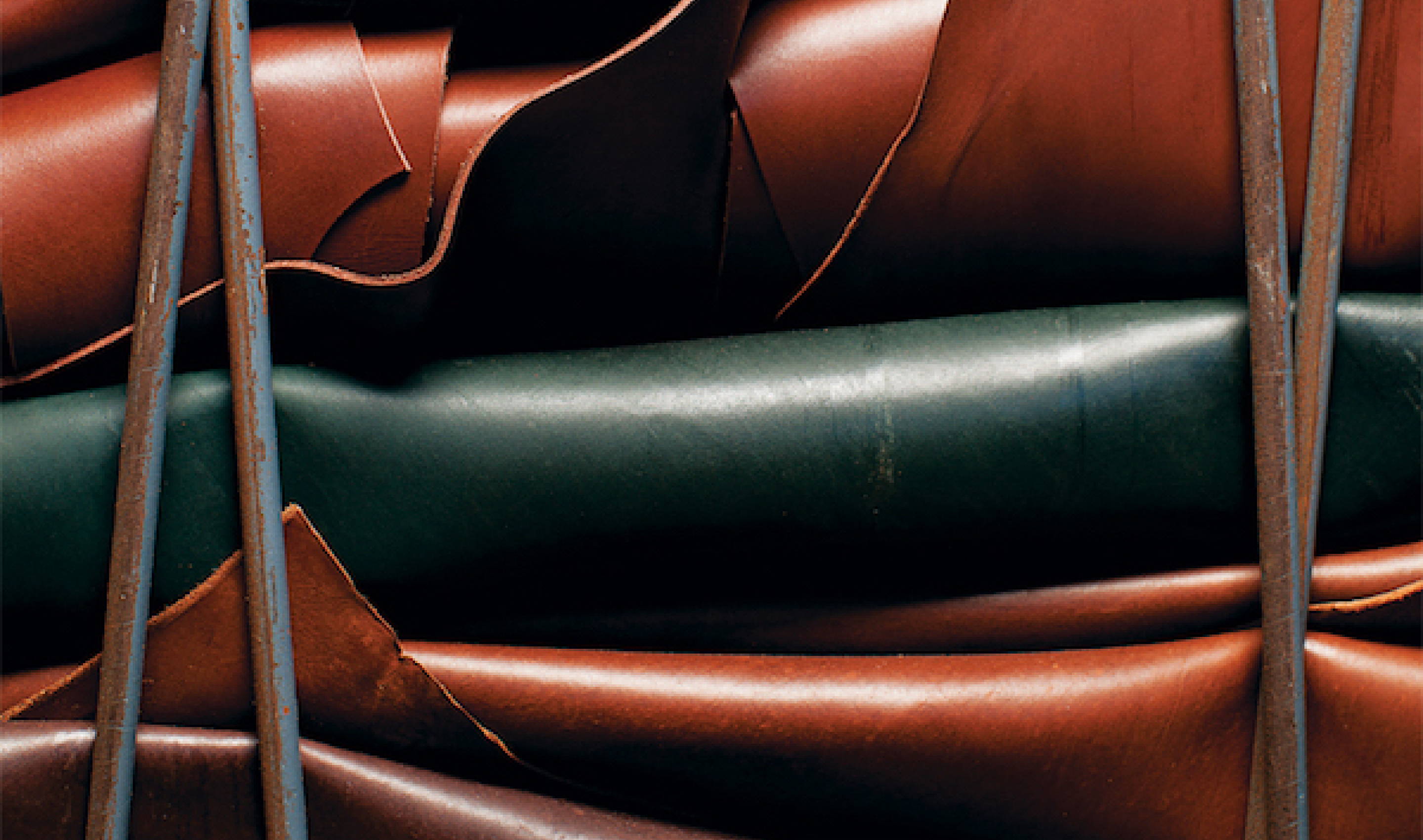From the ship canal that exported goods out across the globe to the steam and hydraulic systems that powered the mills and factories, water has an integral role in the story of Manchester.
The city is also unjustly renowned as the place with the highest rainfall in the United Kingdom (an accolade that, in truth, goes to Cardiff). It does make the raincoat a garment that is become synonymous with the city. James Eden, CEO and founder of Private White V.C., elaborates: “The fly-fronted raincoat is the Manchester raincoat. For decades it was made in the hundreds of thousands and worn by those who lived and worked here. It was the cornerstone of our factory in the years before we launched Private White V.C.”
“The fly-fronted raincoat is the Manchester raincoat. For decades it was made in the hundreds of thousands and worn by those who lived and worked here. It was the cornerstone of our factory in the years before we launched Private White V.C.”
JAMES EDEN, CEO AND FOUNDER OF PRIVATE WHITE V.C.
From the ship canal that exported goods out across the globe to the steam and hydraulic systems that powered the mills and factories, water has an integral role in the story of Manchester.
The city is also unjustly renowned as the place with the highest rainfall in the United Kingdom (an accolade that, in truth, goes to Cardiff). It does make the raincoat a garment that is become synonymous with the city. James Eden, CEO and founder of Private White V.C., elaborates: “The fly-fronted raincoat is the Manchester raincoat. For decades it was made in the hundreds of thousands and worn by those who lived and worked here. It was the cornerstone of our factory in the years before we launched Private White V.C.”
“The fly-fronted raincoat is the Manchester raincoat. For decades it was made in the hundreds of thousands and worn by those who lived and worked here. It was the cornerstone of our factory in the years before we launched Private White V.C.”
JAMES EDEN, CEO AND FOUNDER OF PRIVATE WHITE V.C.
That is not to say that our raincoat is a facsimile or reissue of an earlier design. The Private White V.C. Ventile® raincoat 3.0 is the inheritor of this past, augmented and updated for the modern world – as James continues: “…what we’ve done is refined and perfected it. The raincoat looks simple, almost basic, in concept. In fact, it is extremely difficult to make and complex – it just looks effortless.”
The archive housed at the Manchester factory has been a crucial resource to ensure our Ventile® raincoat builds on its historic antecedents. Mike Stoll, MD at Private White V.C., uses his know-how from decades in the Manchester garment trade to establish this continuity: “Since the 1980s this factory has probably produced about 7,000 different styles in total. I’ve kept the patterns and specs for them all together with about 2,000 physical examples. So if someone wants something I can bring out examples with every variation of pocket, sleeve, fit and we can see which aspects of a garment might work again or could be adapted.”
The same combination of innovation and history is exhibited in the material used to make not only in our raincoats, but also our Harrington and M65 jackets. The waterproof Ventile® fabric was originally developed in Manchester at the Shirley Institute in the 1930s. Researchers discerned that natural waterproofing properties could be achieved using long cotton fibres, densely woven. Although conceived during peacetime, the fabric found its true application during the Second World War. At Winston Churchill’s insistence, ships in the North Atlantic convoys used catapult launched Hurricane fighters to offer protection from air attack. Once the fuel had been exhausted the aircrew would ditch the plane, but the icy water meant, if they could not be picked up, their life expectancy was down to mere minutes. When wearing Ventile®, however, they were able to survive up to ten times longer, allowing a crucial window for them to be rescued.
Produced commercially since 1943 first in the United Kingdom and now in Switzerland, Ventile® was also used by Sir Ranulph Fiennes’ epic crossing of the Arctic in the late 1970s and on the first expedition to conquer Everest in 1953. While our raincoat might not literally scale such heights, the properties of this natural fabric are brought to their peak by the ground-breaking use of taped seams, a technique previously only feasible for use with synthetic fabrics. Bearing our trademark copper colour, this additional waterproofing, which also features on our Ventile® M65 jacket, allows the garment to be light, flexible and breathable.
The design of our raincoat continually evolves. It has already gone through a number of iterations, such as an earlier version with a detachable liner for colder weather. As ever it displayed our characteristic assiduity. Mike Stoll developed an insulating wadding made from Merino wool, which regulates temperature far more effectively than feathers or manmade fibres. In addition, the bottom of the liner was made from wool flannel, woven in nearby Lancashire, which maintains warmth but allows for greater freedom of movement.
“It seems a little thing but we’ve reshaped our inside pockets as smart phones have got smaller and wallets slimmer”.
JAMES EDEN, CEO AND FOUNDER OF PRIVATE WHITE V.C.
Such attention to detail elevates our raincoat above the ordinary, and influences even the smallest aspect of the design. James gives an example of how we have adapted it to modern requirements: “It seems a little thing, but we’ve reshaped our inside pockets as smart phones have got smaller and wallets slimmer”. This meticulous approach manifests itself elsewhere. For instance, the garment not only uses the best military quality Swiss Riri zips, but also features a stud fastener at its base to ensure it closes smoothly and quickly even in the most inclement weather. A further example is on the back of the collar, which has distinctive triangular pattern known as ‘Vandyke’ stitching, after the Dutch Old Master portraitist whose sitters wear wide ornamental collars. In the case of our raincoat, however, the diagonal stitching has a practical as well as a decorative purpose. It ensures that when the collar is turned up, it will support itself against the elements.
This combination of form and function ensures the Ventile® Mac is both timeless and contemporary, equally at home in town or country. James Eden asserts that: “…pretty much every guy in the world could, should and would, look good in this raincoat. It works with jeans or over a suit, for a barrister or a graphic designer. This, in part, explains why it’s one of our best-selling pieces.” With some enthusiasts owning the garment in multiple colours, devotees of our Ventile® Mac can be found from Japan to the East Coast of the United States. As so often in the past, the fruits of the invention and imagination of Manchester’s manufacturers are being carried to the world - and, of course, rain knows no borders.
That is not to say that our raincoat is a facsimile or reissue of an earlier design. The Private White V.C. Ventile® raincoat 3.0 is the inheritor of this past, augmented and updated for the modern world – as James continues: “…what we’ve done is refined and perfected it. The raincoat looks simple, almost basic, in concept. In fact, it is extremely difficult to make and complex – it just looks effortless.”
The archive housed at the Manchester factory has been a crucial resource to ensure our Ventile® raincoat builds on its historic antecedents. Mike Stoll, MD at Private White V.C., uses his know-how from decades in the Manchester garment trade to establish this continuity: “Since the 1980s this factory has probably produced about 7,000 different styles in total. I’ve kept the patterns and specs for them all together with about 2,000 physical examples. So if someone wants something I can bring out examples with every variation of pocket, sleeve, fit and we can see which aspects of a garment might work again or could be adapted.”
The same combination of innovation and history is exhibited in the material used to make not only in our raincoats, but also our Harrington and M65 jackets. The waterproof Ventile® fabric was originally developed in Manchester at the Shirley Institute in the 1930s. Researchers discerned that natural waterproofing properties could be achieved using long cotton fibres, densely woven. Although conceived during peacetime, the fabric found its true application during the Second World War. At Winston Churchill’s insistence, ships in the North Atlantic convoys used catapult launched Hurricane fighters to offer protection from air attack. Once the fuel had been exhausted the aircrew would ditch the plane, but the icy water meant, if they could not be picked up, their life expectancy was down to mere minutes. When wearing Ventile®, however, they were able to survive up to ten times longer, allowing a crucial window for them to be rescued.
Produced commercially since 1943 first in the United Kingdom and now in Switzerland, Ventile® was also used by Sir Ranulph Fiennes’ epic crossing of the Arctic in the late 1970s and on the first expedition to conquer Everest in 1953. While our raincoat might not literally scale such heights, the properties of this natural fabric are brought to their peak by the ground-breaking use of taped seams, a technique previously only feasible for use with synthetic fabrics. Bearing our trademark copper colour, this additional waterproofing, which also features on our Ventile® M65 jacket, allows the garment to be light, flexible and breathable.
The design of our raincoat continually evolves. It has already gone through a number of iterations, such as an earlier version with a detachable liner for colder weather. As ever it displayed our characteristic assiduity. Mike Stoll developed an insulating wadding made from Merino wool, which regulates temperature far more effectively than feathers or manmade fibres. In addition, the bottom of the liner was made from wool flannel, woven in nearby Lancashire, which maintains warmth but allows for greater freedom of movement.
“It seems a little thing but we’ve reshaped our inside pockets as smart phones have got smaller and wallets slimmer”
JAMES EDEN, CEO AND FOUNDER OF PRIVATE WHITE V.C.
Such attention to detail elevates our raincoat above the ordinary, and influences even the smallest aspect of the design. James gives an example of how we have adapted it to modern requirements: “It seems a little thing, but we’ve reshaped our inside pockets as smart phones have got smaller and wallets slimmer”. This meticulous approach manifests itself elsewhere. For instance, the garment not only uses the best military quality Swiss Riri zips, but also features a stud fastener at its base to ensure it closes smoothly and quickly even in the most inclement weather. A further example is on the back of the collar, which has distinctive triangular pattern known as ‘Vandyke’ stitching, after the Dutch Old Master portraitist whose sitters wear wide ornamental collars. In the case of our raincoat, however, the diagonal stitching has a practical as well as a decorative purpose. It ensures that when the collar is turned up, it will support itself against the elements.
This combination of form and function ensures the Ventile® Mac is both timeless and contemporary, equally at home in town or country. James Eden asserts that: “…pretty much every guy in the world could, should and would, look good in this raincoat. It works with jeans or over a suit, for a barrister or a graphic designer. This, in part, explains why it’s one of our best-selling pieces.” With some enthusiasts owning the garment in multiple colours, devotees of our Ventile® Mac can be found from Japan to the East Coast of the United States. As so often in the past, the fruits of the invention and imagination of Manchester’s manufacturers are being carried to the world - and, of course, rain knows no borders.
















Leave a comment
This site is protected by hCaptcha and the hCaptcha Privacy Policy and Terms of Service apply.